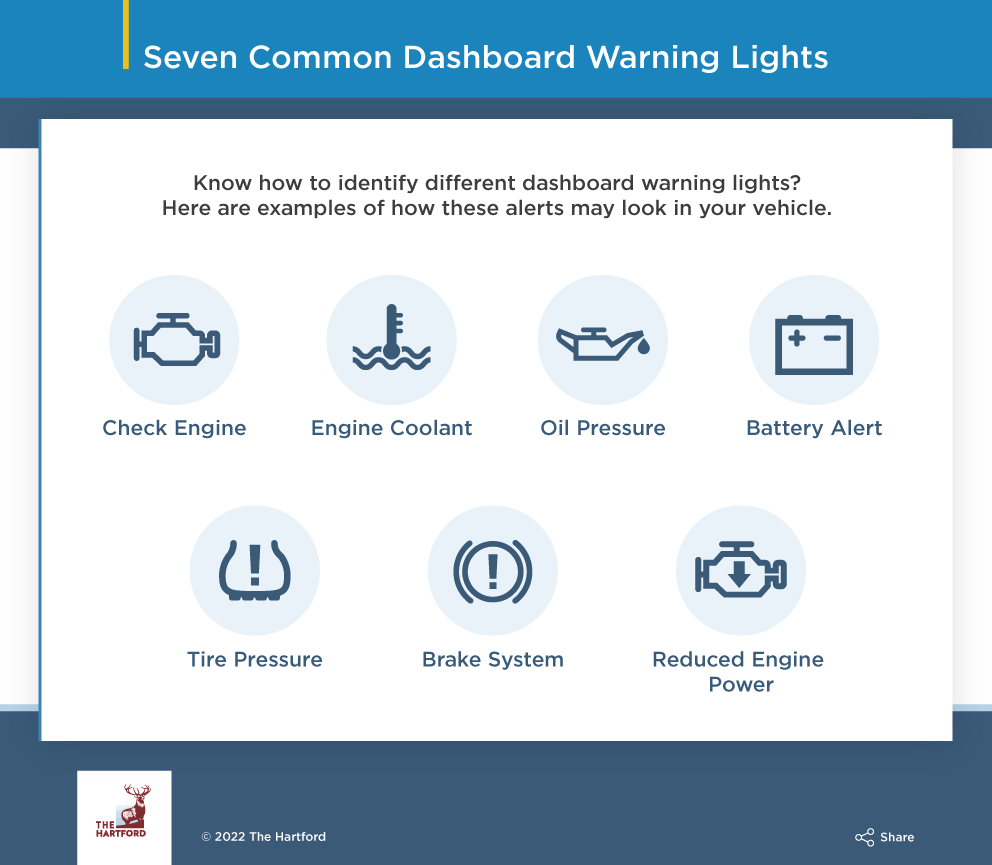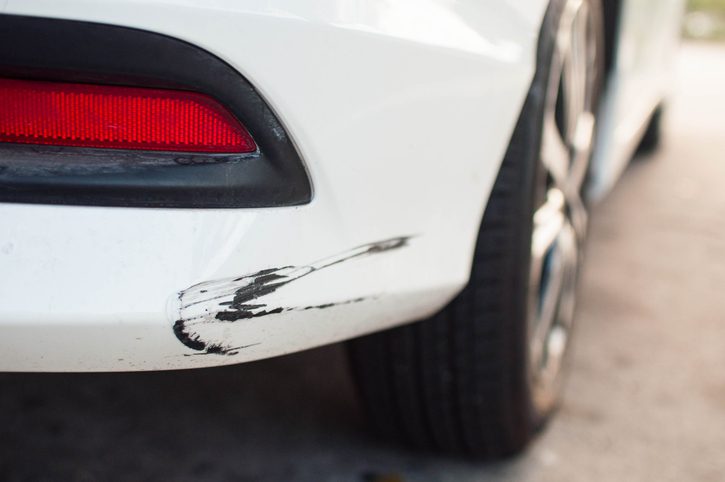Maybe you once sang along with Meatloaf’s “Paradise by the Dashboard Lights” song without considering what those lights meant. Of course, now you know that your vehicle’s dashboard warning lights serve an important function that goes well beyond just a backdrop for nighttime auto romance.
It may seem daunting to decode all those symbols and colors alerting you to potential safety hazards, mechanical issues or even minor things that need attention. Fortunately, you don’t have to be baffled by dashboard warning lights.
This guide to seven important dashboard lights can give you a jump start on the road to safer driving and help you stay on top of vehicle maintenance and repairs.
What Do Dashboard Alert Colors Mean?
Warning symbols differ among makes and models, but dashboard lights typically appear in three or four different colors, each signaling the level of urgency.
- Green or blue lights notify that certain features of your car — cruise control or headlights, for example — are active and working properly.
- Yellow or amber lights often signal a less urgent potential safety issue or hazard, such as a prompt to engage traction control on icy roads or air up tires.
- Red warning lights can indicate a serious problem with important auto components such as the engine or transmission.
Dashboard Warning Lights Guide
While dashboard lights vary depending on the type of car or truck, below are seven warning lights that should catch your attention.

1. Check Engine
When the check engine light appears and stays on, the warning can signal a serious problem with your car’s engine. But the warning light can also come on due to minor issues such as a loose wire or gas cap not being fully closed.
What to do: Don’t ignore your vehicle’s check engine light and never continue driving when this light comes on if it’s accompanied by worrisome noises or other obvious problems. Even if your car displays no other symptoms of an engine issue, visit your mechanic for a full diagnostic test to get to the source of the problem.
2. Engine Coolant
This red warning symbol often appears when your car’s engine overheats due to running out of engine coolant (antifreeze). The engine temperature light may also indicate other serious issues that can create problems in need of repairs.
What to do: Don’t ignore this important warning, or your vehicle’s engine could sustain major damage. Pull over, and let the car cool down for 15 minutes without popping the hood to avoid steam burns and injuries. Call roadside assistance for a coolant top-off or a tow to your auto mechanic to check out the problem.
3. Oil Pressure
That dripping oil can icon might simply let you know that you need to top off your engine’s oil supply. But this warning can also indicate serious issues, including an engine leak or a broken piston ring or oil pump. Ignoring this dashboard warning and continuing to drive without checking it out can lead to significant repair bills.
What to do: Check your oil with the engine dipstick, adding more if necessary. If topping off the oil doesn’t shut off the warning light, take your vehicle to a mechanic for a checkup.
4. Battery Alert
The battery warning light appears when there is an issue with your vehicle’s charging system, including the battery itself or other electrical components such as wiring or the alternator. Ignoring this light could leave you stranded with a car that won’t start.
What to do: Most auto parts stores will check your car’s battery for free and replace a drained battery when you purchase a new one. For a full battery and electrical system check, make an appointment with your mechanic to rule out other electrical issues.
5. Tire Pressure Monitor
This amber, partial circle with tire tread at the bottom and an exclamation point inside lets you know when tire pressure is low or overinflated, which can affect driving safety and fuel consumption. The gauge could also display each tire’s air pressure.
What to do: Pull into a service station to check the pressure of each tire. Refill air in the affected tires to the recommended pressure level displayed in your owner’s manual or listed on your driver’s side door.
6. Brake System
The brake system warning light can appear if you try to pull out while the parking brake is still engaged. But the alert can also signal serious brake problems that may need to be repaired or replaced or an issue with the vehicle’s anti-lock braking system.
What to do: Disengage the parking brake if that’s the reason the light is on. If the light continues to glow, visit a mechanic for a thorough brake inspection.
7. Reduced Engine Power
This warning light alerts you to problems with air or fuel flow to the engine. The reasons could be as simple as an air filter that needs replacing. But the light can also indicate low oil pressure, leaks in hoses or engine performance issues in need of repair.
What to do: Take your vehicle to a mechanic for a diagnostic test to locate causes.
Review Your Owner’s Manual
This list covers some of the most important dashboard lights and notifications. However, there are many additional alerts to pay attention to, including low fuel, door ajar, low windshield washer, power steering, airbags and more.
Take a few minutes to look up your car’s dashboard lights and manufacturer recommendations in the vehicle’s owner’s manual. That way, you’ll know how to gauge warnings and notifications and when to visit a mechanic.
Have you had a check engine light scare or another dashboard light alert that prompted you to take action? If so, share your story and suggestions with other readers in the comments.







I enjoyed the quiz game and also got educated on a few things.
My tire pressure light came on, I checked all four tires, had to fill two of them. All are now perfect but the light is still on. How do I get that light to turn off?
See your dealer and have it re-set.
For Check Engine Light save your time and money by going to an oil change or auto parts chain and have them use the widget that will connect to your car’s electronics. 30 seconds and for free.
Very helpful information.
Thank you.
Ck engine light came on in 2004 Honda CRV. The problem was the oxygen sensor. Further problem was the sensor was $5 – $10 but could not be bought individually. I had to buy the entire manifold for $350 + installation. $600 later the light went
off.
Very helpful information. Thanks for explaining it.
Thanks for this information.
You’re welcome, Loretta! Thank you for commenting!
I have a new Honda CRV (less than 6 months old) and recently while traveling back from my grandson’s football game, I encountered a deer carcass. Unfortutnatley, I could not avoid it and rolled over it. My car was drivable and suffered damage to the insulation under the vehicle. Two months later, I was going up a mountain slope and I got a check flutter valve and reduced power warning, As soon as I could, I pulled over and there was no sign that there was a problem and my vehicle never overheated. It is currently in the shop for repairs and they will check the undercarriage for any related problems. I continued to drive the vehicle down the mountain to the next town and after turning the car off for 15 minutes or so, the warning disappeared.
Thank you for sharing your personal experiences, Barbara!
I have 2012 Colorado. My check engine light came on almost to the day the warranty expired. After going to the dealership and other repair shops, it was decided it was the timing belt causing the light. Replacing would be costly. The light has been on for well over 6 – 7 years.
Thank you for sharing, Julie!
A very helpful mailing. Thanks
You’re welcome, Eleanor!
Thank you so much this was so helpful to us who drive. My engine light was on last month took it mechanics . Glad it wasnt anything serious, needed tune up.
We’re glad you found the article helpful, Connie!
Good Info.
To a mechanic the check engine light is also known as the Money Light.
DO NOT neglect a minor issue check engine light. A faulty O2 sensor or vacuum leak could result in a rich gas mixture. This means that the unignited fuel gets dumped into your catalytic converter. The catalytic converter will eventually fail from, over heating. The sooner you address this issue, the sooner you will save on gas, parts and the mechanic. You will also gain peace of mind.
Thank you for sharing your insights, Robert! We appreciate it.
All good advice. I had the ABS light on (no power brakes, but still had brakes) and found that it was a wheel sensor that went bad causing the car to go into limp mode (no power) and then back to normal after a short time.
Thank you for sharing your experiences with this, Gregory! We appreciate the comment.
I’m having this problem right now and my mechanic told me after accessing it, that it is the wheel censor as well. It will cost me 269.00 dollars to have it fixed. Total. My car is a Kia Sorento and I bought it new in 2011. I’ve had the same mechanic since the warranty ran out and have had little to no problems with my car. Of course the regular maintenance. I really like this site.
I don’t think we have this problem on our Plymouth Valiants Duster & Scamp…
Thank you
This info is very informative & helpful ty
You’re welcome. Thank you for reading Extra Mile!
Very important information. Thank you
You’re welcome, Sheila!
In my 45 years dealing with customers as an insurance agent, I can only remember one amazing situation that always stuck in my mind; I found an aspiring welder-to-be, getting qualified by Tech training, & learning by doing, etc. He said that I was to become his agent for general liability coverage once he was able to get his own Rig, to be a Rig welder, meaning not just an Inline or Shop welder; It surprised me one day that he had lost his family car, a simple four door sedan, and I could have it by paying off the title to the finance co, & so I did; Since the unit was brand new, I learned he had never changed out the oil & filter, or the air filter; Here he plans to be a top welder & didn’t know to maintain his autos.?.!
Aubrey, concerning your car that you purchased ‘NEW’. I would be careful putting the seller down, like he doesn’t know how to do the maintenance. If it’s a new car like you say, oil filters and fluid change doesn’t come due till 5 or 7000 miles maybe even 10000. Air filters usually need changed at 30000 if not longer. Maybe this is why it wasn’t changed?
My check engine light is on, l took the Kia Rio to my mechanic and he said it was the battery. I replaced the battery 3 times. I went to Auto Zone and paid $222.00 for a top grade battery, the mechanic said he checked everything out and that it was the battery. He charged me $60.00 for nothing. My Kia is still not running. What should I do?
AutoZone will read the codes from your OBD (on board diagnostics) port under the dashboard for free. The codes will tell you why the check engine light is illuminated.
Always check the manual…
Thanks.
Bring your car back to AutoZone. They will diagnose your car with an ODBII reader. The ODBII reader will produce a fault code which tells you what is wrong with the the car and gives you a place to start troubleshooting.
Thank you for enlightening me.
You’re welcome, we’re glad you liked the article!
My 2011 Suburu Outback lights kept coming on from the tire level to the engine lights. All of them at different times. I ended replacing the gas cap, battery, and having the tires checked. I finally took it to my mechanic. The transmission was going out! Only ones that can put the transmission in is a dealership as they won’t sell them to anyone else. Cost on just the transmission part runs in the thousands.
Actually the check engine light is extremely dangerous & can result in huge insurance expenses to your insurance company. The light is too ambiguous. It doesn’t tell you if it’s a serious full leak & your vehicle is about to burst into flames or it’s a brake light bulb burnt out causing other drivers to rear-end you at a stop causing damage to you and your vehicle even though this information is in the vehicle computer. I have contacted my manufacturer constantly over the last two decades to fix this with an in-dash read-out that tells you what the issue is but they refuse because the “check-engine” light is a major source of cashflow for them.
Thanks for the tips.
You’re welcome!
This is very good information to know. The first time the tire pressure light came on, I panicked but now I know to get air. Thank you so much!
You’re welcome, Pamela!
Excellent report. Easy to understand. Already knew some things. Good to have this report for future problems. For many years I have had no major problems and as a woman I believe it is best if I always have a pretty new vehicle. My current one is a 2018 Ford Escape which I leased when it was new. After my lease was up I had contracted to have first right to buy it which I scarfed up with only 13K miles. I feel blessed and so thankful for my good fortune. As I am 76 yrs old I expect it to be my last one. In four years since I leased it it now has only 15K mileage.
Thank you for sharing, Kathleen!
Thank you for the review.
You’re welcome, Virginia!
Excellent summary. Bottom line: see a light, get it checked.
Thanks!
You’re welcome!
No problems but the information is tucked away for future use if necessary! Thank you!
Our Buick’s “Check Engine” light remained on while I looked at everything but the gas cap. That was on correctly. While under the hood making sure liquids were in good standing, I noticed a very small bubble was on top of the temperature sensor pump. It was a leak and according to my manual, it affected the Check Engine light. A hose needed to be replaced and the light is off. Such a minor issue cost much less than a new engine.
My 2014 Chevrolet impala backup camera works sometimes. What could be the problem?
Probably a loose/dirty connection or faulty switch. The switch is activated when you put the car in reverse
Everything as good as needed!
If the newer cars (mine is a 2017 Toyota Avalon) are not driven frequently, the battery dies and car won’t start. Last week, I didn’t drive my car for a week and had to jump start the battery. Battery light did not go on. According to a Toyota dealer, the car has to be driven to keep battery charged. You can’t just start
The car. Engine light went off after the car was driven enough to fully charge the battery.
If your car is driven once a week there is no reason for your battery to die except if the battery is defective or you have a faulty alternator. If you drive your car infrequently, you can purchase a battery tender from Harbor Freight or Amazon. These cost between $10.00 – $30.00. You just hook it up to your battery and you will have a fully charged battery when you need your car.
My car, less than 2 yrs old, would not start. The dashboard warning for brakes was on, and then other warnings started going on and off, except for the battery alert which was off. I called the dealership, which advised it was probably a battery problem, notwithstanding the alert being off. They replaced the battery, which fixed everything.
Replacing the battery gave your car computer the correct AMP/Volts to work effectively.
The tire warning light came on and wouldn’t go off, even after I had the tires aired up. I had it checked out it wasn’t the tires ,it was the ty rods that needed to be replaced.
gota light have it checked. be smart.
Was told by mechanic as long as the engine light is not flashing, not to worry.
Had to replace the sensor and was pricey. was usually the gas cap had not clicked when I tightened it.
Also, when they rotate the tires, the sensor must go with the tire as when front tire was low on driver’s side and was rotated to rear, then the rear tire came up low pressure.
What is it when your skid light, tire pressure light, check engine light stays on. Even after everything checks out okay. Telling me it’s the sensor
Thanks!!
My “Change Oil Soon” light is on but there have only been about 150 miles put on the car since the oil was last changed. I checked the stick and it is not dirty and has sufficient oil. Why would this light keep coming on?
Some car models have a “oil change reset light” that must be reset after an oil change. Check with your car owner’s manual to see if your car has this “oil change reset” provision. If so, follow the instructions in the manual to “reset” this feature. If this simple process is done per the owner’s manual, the light should go out until the car once again accumulates thousands of miles and the light will go on again signaling an oil change is needed.
Probably forgot to reset the oil change time.
When the oil is changed, the oil service light should also be reset. This apparently was forgotten.
Very useful information.Thanks
great advice and very easy to understand. Thanks
thanks for the important info.
Thank you very much for some helpful reminders.
Helpful information.
What problem arises when the PSP-BAS indicator light comes on ?
Hi Jeannette – For additional warning lights, we recommend you use your vehicle’s owner’s manual to look up dashboard alerts and manufacturer recommendations for your specific car.
Thanks!
I have a 2010 odsessey and the tpms light is constantly displayed. Dealer wants a fortune to fix sensor. Any suggestions??
I have the same issue with my Kia. The batteries are probably dead on one or more sensors. I ignore the light and use a tire pressure gauge to periodically check tire pressures. A TPMS light on does not fail New York annual inspection.
Great Advice, thanks
Thanks you
I had an issue with my 2012 Buick Lacrosse Supreme. A leaky water pump occurred, causing vehicle to run critically low on coolant. There was NO WARNING LIGHT to notify me of this issue. Had I noticed the heat gauge, engine would have locked up… calling for a new engine.
Thanks so much for sharing these tips!!
Check engine light came on it was my gas cap. It did it again it was a o2 sencer.
The Hartford such an amazing company. Thank you for keeping my insurance premiums low.
This just happened to me yesterday. Check engine light. I have. 2002 Ford Focus stick shift, 75000 miles and regular maintenance done I bought it new. 21 years old. It is amber light and a steady light. I have checked gas cap and it is like always. I am getting it in on Thursday and won’t drive it till I take it in. It is running great, smooth and zippy! I have put money into this car but not abnormal for age. Feb shocks and struts and it went through diagnostic test then. So afraid it is going to be super expensive.
Thanks for the reminders
Thank you.
Thanks
Excellent information. Thank you!
Thank you I appreciate this email!
My engine light is on , but I always check my car. Mechanic said that it will stay on.
There is always a reason for a check engine light. It just does not stay on. Usually a bad sensor, faulty component or vacuum leak. Get a 2nd opinion before a minor issue turns major.
You will be better off and pay less ($0.00) if you go to your local auto parts dealer; most will check for the code and tell you what it means. They will also advise you whether or not you need to see a mechanic.
My dash shows gas cap and lock warning in gold and beeping with lights staying on when key turned off. Lights are sentry lights and normal. I have replaced the gas cap and I’ve had Auto Zone use a device to clear the gas cap light but still it stays on and beeps. It stays off while I’m driving. Only on when I turn off the key. (07 Cadillac CTX)
These are good reminders for any driver. However, you may want to include ways to find a copy of that owner’s manual if there is none with the vehicle. Buying a used vehicle often comes with the risk of not having the manual. Some car manuals can be found and downloaded online. Even the ‘cheat sheet’ telling you what the warning lights are and what they mean can be found for some models. Other vehicles require you to find and buy the owner’s manual. Be aware you may need some additional info about the vehicle to find the correct manual other than year, make, and model. Price for manuals will vary based on year, condition of the manual, and source providing that manual.
This is a great tip, Joyce. Thanks for sharing!
i have a 12 year old car that has tire sensors. the batteries in the sensors are probably good for 6 years or so. when i bought the car it was used and 10 years ol and i started to get the tire light on while driving around i brought the car to a tire shop several time and was told the tire pressure was fine and that probably what is happening is the battery are low in one or more of the tires and it all the tires would need to be opened in order to replace the sensors with new ones, about 20 bucks per tire. i am 75 years old and the tires were all new when i purchased the car.. i dont think i will live long enough to replace those sensors, a few thoughts
The “half circle “ with a tire tread at the bottom is actually a cross section of a tire.
Yep, recently got a tire pressure alert, and found a rear tire with very low pressure. Went to the shop and needed all four tires replaced!
The first time the tire pressure light came on, it was announced by a loud noise! I was about to go home after an evening meeting at about 10:00 PM. The icon made no sense to me and I spent about 10 minutes ripping through the Manual to find the issue. When I found “tire pressure”, I got out of the car and walked around looking at all the tires – none looked flat. I went home and the next day I went to a service gas station (few and far between these days) and an attendant found a couple of tires a couple of pounds low. I have since learned from my regular mechanic that when a car sits out in cool temperatures, it can cause this gauge to activate. I live in San Francisco and my car is always garaged. But if it sits out for a few hours and the evening temperature falls, I can be sure this icon will appear. I have bought a very good tire pressure gauge and will some day learn how to add air!
I appreciate this information thanks
Thanks for the reminders!
I have a 2016 chelvelot impla unlimited i brought this march 2022 my engine light keep coming on it read service traction control, slow engine, I had a fuel pressure sensor put on still engine it say same thing, so I took it back and was told code can cost, he say to drive it and see if it will reading come back, I am a lady I so afraid to drive my or enjoy dont want to break down i don’t know what to do
My 2000 Avalon check engine light has been on for the last 15 to 16 years- no problems. Car runs great!
Great advice.
I do need my tires checked for air n balance Thank You o
This will be my go to information from now on.
Have it checked as soon as possible
Call around and see what the various mechanics charge to ‘check the codes’. That fee alone is usually higher with the dealer. Some code readers can be purchased for less than the cost of the diagnostic fee and will help many DIYs. Not all code readers will identify all possible issues and further diagnostic may be required by a specialized mechanic. For minor codes these meters often have a reset button that may buy you some time until you can get the appointment for repair. Just remember the code needs to be present for the mechanic to confirm what is wrong.
It was a reminder of things I knew but it refreshed my memory.
..Last car I had went to 333,000 miles–check engine light stayed on. They could never find anything. It was a Maxima. This car Sonata 2010 light stays on–cannot find anything wrong.
have two older toyota’s ,2000&2003 lite came on them had them checked.spendy ! was exhaust sensor .wanted a lot to remedy . lights been on 15 and 12 years still going strong.
@Orville – I am not surprised. Toyotas are known for their long life and are awesome cars.
I have a 2004 Toyota Matrix. Whenever the check engine light comes on, I take it to the dealer and it is always something that needs to be done which helps with preventative maintenance. This helps to keep me rolling down the road!!! (LOL)